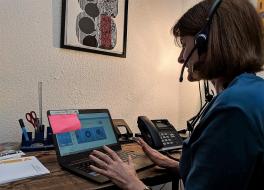What helped with my interiorised stammer

Peter Hodson describes the pressure to appear fluent and the effect it had on his life. That was until he discovered a City Lit course that helped to change things.
I first sensed something was different at school. Reading aloud in class filled me with dread and even when I knew the answer to a question, I often kept my hand down.
Things became harder when I started my first job, working in an open-plan office. I was petrified of answering the phone, sometimes making sudden trips to the coffee machine or printer just to avoid picking it up. Meetings were nerve-shredding, especially when it came to introducing myself — even saying my name felt like climbing a mountain.
I was petrified of answering the phone, sometimes making sudden trips to the coffee machine or printer just to avoid picking it up.
Outside of work, I faced similar challenges in everyday situations. In a bar I would order the beer that was easier to say, rather than the one I wanted. I even introduced myself with an 'easier' name whilst travelling in Asia, rather than risk stumbling on my real one.
The hidden side of stammering
Interiorised stammering, or covert stammering is sometimes described as an iceberg: the small part above the surface may look fluent, but beneath lies a hidden world of avoidance, anxiety and self-criticism, all driven by shame and a fear of being judged. That description rang true for me: for most of my life, my stammer was exactly that — hidden. On the surface I worked hard to appear fluent, but inside I was constantly battling. The idea of stammering openly felt like a threat to my sense of control and confidence.
I had developed deep-rooted coping strategies to disguise my stammer — I would plan conversations in advance and swap out words I thought I might block on. I sometimes didn't speak at all and even avoided situations and opportunities. I've always been sociable and thrive in people-facing roles, but the fear of being 'found out' often kept me silent. More than once I turned down promotions I'd been encouraged to apply for, not because I lacked ability, but because I was afraid of stammering in front of others.
Suppressing my stammer had become second nature, but the internal struggle was relentless and the effort was exhausting. I was working hard to sound fluent at the cost of tension and constant worry. I felt isolated, frustrated and ashamed.
The turning point
That changed when I discovered a course for people with an interiorised stammer at City Lit in London. Signing up felt like a leap of faith. I had tried speech therapy before, and to be honest I had lost confidence in it. But this course was different. It wasn't about 'fixing' me or teaching tricks to hide my stammer. It was about acceptance, self-awareness and learning to communicate authentically.
The City Lit course helped me face the hidden struggles I mentioned above. We explored ways of reducing avoidance, managing difficult thoughts and feelings, and even using mindfulness to ease tension when speaking. These tools gave me the freedom not just to speak more easily, but to feel more at ease with myself.
I realised that my biggest barrier wasn't the stammer itself, but the fear and avoidance wrapped around it.
From the first session, I felt I'd stepped into a safe, non-judgemental space. Everyone in the group understood. I wasn't alone anymore. We explored our beliefs about stammering, the ways we avoid speaking, and the impact those habits have on our lives. I realised that my biggest barrier wasn't the stammer itself, but the fear and avoidance wrapped around it.
Through the exercises and strategies, I began to listen to myself and experiment with new ways of speaking. Voluntary stammering — something I once thought unimaginable — helped me desensitise to fear. For the first time, I started to feel a shift in how I related to my stammer: less shame, more acceptance.
I live outside London but was able to join the course online. I wasn't sure at first how well it would work virtually, but it was brilliant. The group dynamic, the exercises, the support — everything translated seamlessly online. That accessibility made it possible for me to take part.
Impact
The changes filtered quickly into my daily life. Work meetings became less daunting. I started making and taking phone calls rather than avoiding them. Social situations that once filled me with dread became opportunities to connect. Ordering a coffee without rehearsing the words in my head felt liberating. Best of all, I can now order exactly what I want in a bar or restaurant.
The ripple effects surprised me. I grew in confidence not only as a speaker but as a person. I even had the chance to appear on BBC News to talk about my experience — something I would never have believed possible a year earlier. Far from being something to hide, my stammer had become something I could speak about openly.
What matters is living fully, speaking authentically and treating myself with kindness.
Another gift of the course has been the friendships I've made. The stammering community is extraordinary: supportive, warm and full of humour. Through the course I've met people who understand me in a way few others can. We share strategies, cheer each other on and meet up socially. That sense of belonging has been just as transformative as the therapy itself.
I've since joined other City Lit courses, including one on Acceptance and Commitment Therapy, each one adding something new to my toolkit. One of my favourites was an acting workshop for people who stammer. I loved it — it pushed me out of my comfort zone and gave me another boost in confidence.
Learning to live with stammering
The biggest lesson I've taken from this journey is that fluency isn't the goal. What matters is living fully, speaking authentically and treating myself with kindness. I've stopped seeing my stammer as an enemy to defeat and started to see it as part of who I am.
Of course, it isn't always easy. There are still moments of frustration. But now I have a toolkit to fall back on: strategies for blocks, self-advertising and mindfulness; the support of peers and therapists; and, most importantly, a kinder relationship with myself.
If you're reading this and you live with an interiorised stammer, help is out there. You don't have to go through it alone. Taking that first step — reaching out, signing up for a course, or joining a support group — can feel daunting, but it might just change your life as it did mine.
City Lit has given me my voice back. More than that, it has given me the confidence to use it — at work, with friends, in public and with pride. I'm no longer hiding. I'm speaking up, stammer and all. And that, for me, has been truly liberating.
City Lit is one of the options out there for people who stammer and they have an upcoming course for interiorised stammering, which starts on 8th October. Find details on the City Lit website. For the full range of courses, see our Adult Stammering Courses page.
Would you like to write an article about what helped for you? See Submit Something For The Site or email editor@stamma.org


































